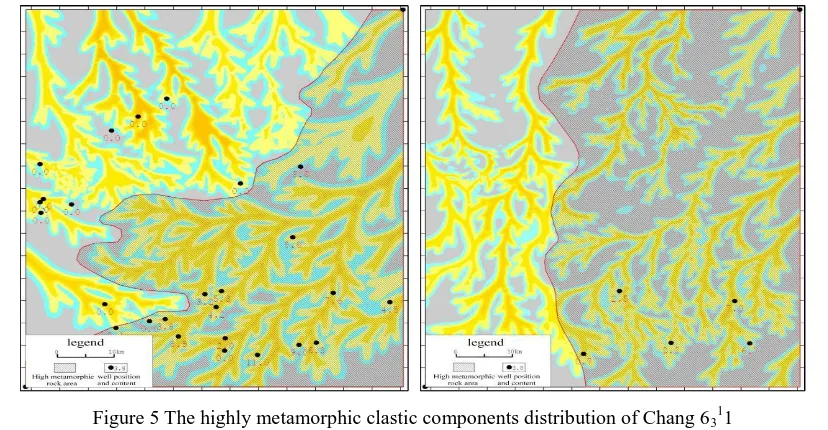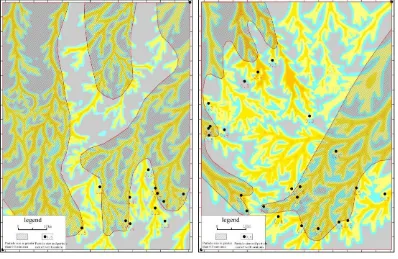Vol. 05, Issue 08 (August. 2015), ||V1|| PP 25-29
The Research of source system on Chang 63 sand formation in Ansai oilfield
Wang Jie
(College of Earth Sciences, Northeast Petroleum University, Daqing, Heilongjiang, China)
Abstract: Through the analysis of the contradiction between the research results and the exploration of the sedimentary system of the former, it is believed that there is a lack of understanding of the source system in the
north-east of Ansai area. In this paper, from the single factor, such as the color of mudstone, the distribution of
carbonaceous mudstone, characteristics of heavy minerals, detrital component and the maximum particle
diameter, the source system of Chang 63 sand formation in Ansai Oilfield are analyzed. Studies have shown that
Chang 63 sand formation in Ansai Oilfield exists two different provenance system, which north-west region of
sediment sources come from the northern provenance system, and sediment sources in the south-east region
from north-east provenance system.
Key words: Ansai oilfield, Ordos Basin, provenance analysis, sedimentary system
I.
GEOLOGICAL BACKGROUND
The main oil exploration layer of Ordos basin is oil layer above Chang 62, oil layer below Chang 63
remains a low degree of prospecting. In the past, there are some researches on the layer below Chang 63 which
from the aspects of reservior, oil and gas migration and accumulation in the Ordos Basin, and there are many
blocks to build production. But due to lack of drilling data, the research degree is still very low.
Previous studies suggest that ansai areas mainly develop north-east source system, ansai area Chang 63
sand formations locate in delta front distributary channel of the north-east provenance system. Predecessors'
research achievements can't explain the oil and gas that have founded in the north of ansai area. That may hinder
the development of oil and gas exploration. Studies have showed that the paradoxical situation may due to
ambiguous understanding about depositional systems, which can lead to insufficient understanding about
distribution of oil and gas. Therefore, it is necessary to reacquaint depositional systems distribution of Chang 63.
II.
SINGLE FACTOR ANALYSIS OF DEPOSITIONAL SYSTEM DISTRIBUTION
2.1 The color of mudstone
The color of the sediments has a close relationship with sedimentary climate and water depth. For
sandstone, the color is determaint by the deposition climate, water depth and the characteristics of mineral
components [1]. Under the humid climate, underwater sandstone shows grey or dark grey, but components of
rock can make the color change. However, the potash feldspar sandstone is red, but in the process of diagenesis,
due to the cement and filling fluid are different, the color of the sandstone is also different [2].
Comparing with sandstone color affected by many factors, the colors of the mudstone are mainly
affected by sedimentary water depth and organic matter content [3]. In general, the color is light with shallow
water depth and low organic matter content. In northern area of Ordos basin, overwater presents celadon,
mottled gray or brown gray generally, underwater presents gray, half deep lake in dark grey to ash black. Ansai
area mudstone in general is in three kinds of color: gray, dark gray and ash black. Dark gray and ash black often
are difficult to identify, so it can be divided into two categories: gray, dark gray-ash black. On the basis of two
types of color analysis, the every single layer of Chang 63 sand formation in Ansai area obviously can be divided
area is located in the central and southern area (Figure1, Figure2).
Figure1 The mudstone color of Chang 6311 Figure2 The mudstone color of Chang 6322
2.2 The characteristics of heavy minerals
From the analysis of characteristics of heavy mineral combination in this district, in ansai area, heavy
mineral combination has two distinctly different characteristics [4]. One group predominantly takes reddish
garnet and sphene as heavy mineral combination, namely the combination of faint red garnet, sphene, colorless
garnet and epidote; another group is mainly composed of euhedral zircon and colorless garnet, namely the
combination of euhedral zircon, colorless garnet, white titanium ore.
In ansai district, Chang 6311 develops two kinds of heavy mineral combination (figure 3), areddish garnet,
colorless garnet and euhedral zircon combination and sphene, epidote, reddish garnet combination.
Chang 6322 develops two kinds of heavy mineral combination (figure 4), pale red garnet, colorless
garnet, sphene, euhedral zircon combination and euhedral zircon, colorless garnet, white titanium ore
combination.
According to the characteristics of the heavy mineral combination in ansai area, it can be divided into two
sedimentary systems [5]. The obvious characteristic of eastern source system is high content of sphene, but the
western source system is high euhedral zircon content. According to the analysis of regional background,
combined with the deep research of sedimentary facies, western sedimentary system is the northern provenance
sedimentary system, while eastern sedimentary system is the north-east source of sedimentary system.
Figure 4 The heavy mineral combination of Chang 6322
2.3 Clastic components
The characteristics of clastic components in the studied area are generally similar, but the content of
highly metamorphic rock debris are obviously different [6]. From the plane distribution, highly metamorphic
rock debris are developed in the south-east of ansai area, while in the north-west area are not. It indicates that
north-west sediment source may be different from that in south-east [7].
From Chang 6311 thin-section analysis data, we can see the differences between south-east and north-west
highly metamorphic clastic components(figure 5), Chang 6322 thin-section analysis data only distributes in the
south-east, north west has no sample distribution, but south-east highly metamorphic rock debris samples
develop (figure 6).
Figure 5 The highly metamorphic clastic components distribution of Chang 6311
Figure 6 The highly metamorphic clastic components distribution of Chang 63 2
2.4 The distribution of largest particle size
The largest particle size of sandstone reflects hydrodynamic conditions, the hydrodynamic conditions are
stronger; the maximum size of sandstone is bigger [8]. The weaker the hydrodynamic conditions, the smaller the
sandstone maximum particle size. In general, the maximum particle size is large in the upstream area, but small
in the downstream area. According to the analysis of maximum particle size, we can infer the direction of the
river channel.
Figure 7 The maximum grain size distribution of Chang 6311
Figure 8 The maximum grain size distribution of Chang 6322
From the maximum size of the planar distribution analysis, the maximum grain size of Change 6311
obviously showes two distribution trends, one distributes from north-west to south-east in north-west area, the
other is from north-east to south-west in south-east area(Figure 7). The maximum size distribution of Chang
6322 is not obvious, but it is similar to the distribution of Chang 6311. So, from the maximum particle size
distribution analysis, the Ansai area developes two depositional systems.(Figure 8).
III.
CONCLUSION
Combined with the color of mudstone, heavy mineral characteristics and distribution, highly
metamorphic rock debris and the largest particle size distribution, we could conclude that it develops north-west
and south-east two source systems in ansai area. North-west area develops north provenance system,
sedimentary system extends from north-west to south-east. South-east area develops north-east provenance
system, sedimentary system extends from north-east to south-west.
REFERENCES
Journal:
[1] Wang Zhengjiang, Chen Hongde, Zhang Jinquan. (2000). The research and prospect in provenance
analysis. Sedimentary Geology and Tethyan Geology, 20 (4), 104~110.
setting. Advance in earth sciences, 17(1), 85~90.
[3] She Zhenbing, Ma Changqian, Mason R. (2006). Provenance of the Triassic Songpan-Ganzi flysch, West
China. Chemical Geology, (1-2), 159-175.
[4] He Zhonghua, Liu Zhaojun, Zhang Feng. (2001). Latest progress of heavy mineral research in the basin
analysis. Geological Science and Technology Information, 20 (4), 29~32.
[5] Li Zhen, Jiao Yangquan, Liu Chunhua, et al. (1998). Provenance analysis of heavy mineral in Gaoliu area
of Huanghua Depression. Petroleum Exploration and Development , 25(6): 5~7.
[6] Chen Chunfang, Zheng Junmao, Wang Defa. (2001). Depositional systems and source provenance of the
third member of Shahejie formation Banqiao Sag. Journal of palaeogeography, 3(1), 55~62.
[7] Liu Li, Hu Chunyan. (1991). Provenance significance of the main detrital composition in sandstone.
Sedimentary Facies and Palacogeology, 11(6), 48~53.
[8] Shao Lei, Li Wenhou, Yuan Mingsheng. (1999). Sedimentary environment and source rock analysis of the


